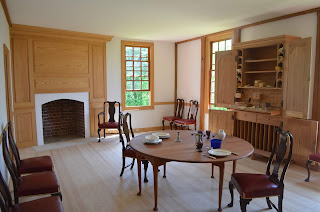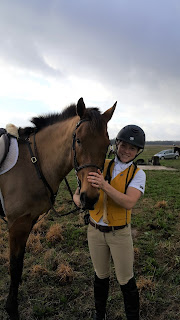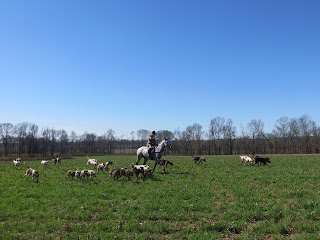Virginia!
I drove from Alabama to Virginia on a damp, drizzly day that
obscured the mountains around Chattanooga in Tennessee, rendering them more
Foggy than Smoky. By the time I reached the ‘lovers’ state’, it was dark but
clear, very dark indeed amid the tall red and chestnut oaks of the Shenandoah national
park. I wound down and down via a series of hairpin bends, the view of hunting
country from which must be spectacular in daylight, and finally reached the
undulating road that leads to the home of Jake Carle III, long-time master and
huntsman of the Keswick, hound expert and raconteur.
Jake Carle with assorted canines
George Washington, ‘father of his country’, was an avid
fox-hunter, but it was with his early life that my first day in Virginia was
concerned. The legend of the Cherry Tree, in which the eight-year-old George
chopped down his father’s favourite tree and earned a reputation for honesty by
swiftly owning up (although, strangely, not for being a mean vandal), is almost
certainly apocryphal, but if it did happen, it was at Ferry Farm on the banks
of the Rappahannock in Fredericksburg. A great friend of mine in San Francisco
is descended from the Strothers, the family who owned the land before the
Washingtons, and he linked me up with Bill Garner, president of the George Washington Foundation. Bill and his colleagues Meghan and Jessica showed me
around Ferry Farm and Kenmore, another Washington family home, and I was
captivated.
The newly arisen Ferry Farm
Courtesy of The George Washington Foundation
and Eric Kuchar of Mesick Cohen Wilson Baker Architects
Nothing of Ferry Farm remained before archaeologists got to
work a few years ago. In 2003, they began the search for the foundations and,
in 2008, confirmed that they had identified the remains of the
long-sought-after house where Washington grew up. Excavation has revealed the plan of the whole
farm, plus Indian arrowheads, fragments of pottery, Tally-ho cufflinks and more
that tell the story of the land over thousands of years. Now, the house,
together with the corrals that held animals and the huts where farmworkers and
slaves lived, are being rebuilt by hand, down to the lime-based plaster mixed
with animal hair, scalloped shingles and beautifully crafted corner cabinet.
The work is superb, from the smooth banister to the solid wooden plank that
locks the back door. From the river side, where the ground drops away, the
entrance to the cellar reveals the original stone and a single large block of
earth, left as a gift for future archaeological students.
Ferry Farm and its agricultural surroundings
The beautifully crafted interior, an educated guess at what
George Washington would have seen as a child
Visitors to Ferry Farm will be able to touch everything, to
experience what it was like to live in a house in the new colony, at a time
when land was still be surveyed and Fredericksburg a mere cluster of houses.
When the ferry, just upstream from the Washingtons’ land, yielded a steady
stream of travellers, much to the annoyance of the family. When ships plied the
deep waters of the Rappahanock and there were fortunes to be made by anyone
with zeal and determination: like George Washington himself. His childhood and teenage
years were spent in a new country, a time when he could explore and speculate,
forge relationships and secure land, learning from a pioneering people whose
spirit gave him the spark he needed to found the United States of America.
Ferry Farm is a far cry from the magnificent porticoed mansion of Mount Vernon
that was his last home, but it was a vital part of his life and now, thanks to
the George Washington Foundation, it will live again.
The view to the Rappahanock River, at the edge of the grass.
Fredericksburg is visible in winter, when there are no leaves on the trees!
Everything, from the banisters to the doors, has been made
fresh, and can thus be touched and experienced
Bad timing doesn’t begin to describe the story of Kenmore,
home of George Washington’s sister Betty and her husband, Fielding Lewis. In
the mid 18th century, England and all things English was the height
of fashion, with furniture, silverware, glassware and porcelain imported and
displayed to impress the neighbours. Lewis was a successful merchant and
patriot who owned a fleet of ships dedicated to bringing in the most stylish
and sought-after goods from the Old Country, and Kenmore became a showcase for his
family’s English affinities, a way of proclaiming to the world that they were
akin to aristocrats, or at least the upper middle class. The house itself is a
perfect Georgian box, red-brick and perfectly proportioned with an elegant
portico and strikingly painted hall. Even the servant’s passage was painted
where it could be glimpsed by visitors.
A perfect Georgian box. It could almost be in Hampshire
But the tragedy of Kenmore is that it was completed too
late. Only a year after Betty could sit back and reflect on her possession of
the most elegant house in Fredericksburg, the War of Independence broke out and
suddenly George IV tankards were being chucked out of windows onto rubbish
heaps across Virginia. Kenmore and the trade that had sustained it were
valueless almost overnight. No longer was it the embodiment of good taste, but
instead a symbol of lost loyalties.
Kenmore: out of date almost as soon as it was completed
Nearly a century later, another war was to batter Kenmore.
Fredericksburg was the frontline in the American Civil War, with the
Confederates firing from the south and Union soldiers from the north. Cannonballs
and holes from both sides can still be seen in the walls and roof. The house
was pressed into use as a hospital, with the dining room serving as the
operating theatre and stretchers laid out on the lawn.
Cannonballs have been inserted in the holes to remind of the effects
of the conflict, and there are many more scars of war
The jewels of the work are two elements that showed off the
Lewises’ English connections best. In the dining room, the carpet has been
newly woven to an 18th-century pattern, with an excellent chance
that it was the exact design used. The dining-room floorboards were ripped up
after the Civil War, too soaked in blood to keep, which made the restorer’s job
more difficult. In most rooms, carpet tacks on the floorboards could indicate
if the room had been carpeted, but there were none left – except for one, on
the threshold. Expert examination revealed tacks embedded in the wood, which
showed that, firstly, the carpet had been wall-to-wall. Secondly, tiny
fragments of carpet fibres were left, in a striking dark-red colour. It was reckoned to be a Wilton carpet, made by the (now) Grosvenor Wilton carpet company of Kidderminster in England that still exists. A terrible fire in the 19th century destroyed all records before 1790, but enough remained to show that only three designs of the period used that colour. Analysis
of the paint on the walls revealed the room’s colour scheme, and the carpet
chosen and woven accordingly. The whole design feels so fitting that I have no doubt they
are correct.
The drawing room with its restored Kidderminster carpet
The Kenmore drawing room
You have to look up for the second spectacular element.
Letters and accounts reveal a mysterious Stucco Man, who came from England with
the plasterers to create the gorgeous plaster ceiling with its foliage and circular
motifs. It seems likely that he was Italian, with a difficult-to-spell name
that was never used, but he was so good that his plasterwork is the crowning
glory of both Kenmore and Mount Vernon, George Washington’s later and sumptuous
home. No one knows who exactly he was and where he came from, but Stucco Man’s
work is unique in America, the fashion for ornate plasterwork swept away on a
tide of anti-English feeling.
The gorgeous ceiling
There are dozens of stories within the walls of Kenmore,
from Betty Lewis’s writing desk that was discovered in an auction in
Minneapolis and now stands in its original place to the canoe that hangs in the
attic. It was once owned by the son of a late-19th-century Kenmore
family who was crippled from the waist down and used the canoe to improve his
upper-body strength. It was he who persuaded his father to let him restore the
plaster ceiling, in a sorry state after the War, and painstakingly replaced
lost pieces with plaster of Paris. George Washington’s grand Mount Vernon home
draws the crowds, but if you’re in Virginia, don’t miss visiting this
exquisitely restored gem of a house.
Betty Lewis's writing desk, discovered at auction
and restored to its original place
If you see this view as you drive into Fredericksburg, stop!
Grey skies gave way to blustery blue the following day, the
clouds dispersed by gale-force winds that tore down trees and powerlines across
the north-eastern US. No internet and no phone thus meant an enforced, and
welcome, day of swapping hunting stories with Jake, plus an abortive trip to
Horse Country in Warrenton – naturally, no power meant the
hunting-clothing-household-all-good-things store was closed. The wind meant
even my low saloon car was buffeted off its course and I held my breath every
time we went past a tree, which was often. We were luckier than most: we got
power back that night, but most people were reliant on bottled water and
generators for days.
Jake snapping the Bull Run meet on a blustery, sunny day
Worst of all, most hunts were unable to get out on Saturday,
but Bull Run is made of sterner stuff. Half an hour south of Warrenton we drew
up at the kennels on a cold clear day, the wind still chilly but no longer
threatening to throw us flat on our faces. Leaving early in case of log-forced
detours, we arrived in time to see the latest additions to the Bull Run
kennels, born the night before! Little squirmy bundles, pure cuteness. Soon
afterwards, rigs started to arrive and a decent crowd gathered to cry ‘yes’ in
response to Mike Long MFH’s call of ‘Are we going to have fun today?’ Being English, I
can’t help but cringe a little at such openers, but no one can deny the
enthusiasm. And we did have fun! Scenting wasn’t brilliant, but we had some
good music and jumps, up on a wooded hill just south of the kennels called,
grandly, Cedar Mountain. One run took us out of the woods and onto smooth turf,
to an upright rail more like an ad hoc British jump than a pristine Virginia
coop. We marked soon afterwards, huntsman Charles Montgomery blowing to ground
with enthusiasm and praising his smart crossbred hounds, who lapped up his
words.
Mike Long gives a cheery welcome before we set off up Cedar Mountain
Happy first field!
Marking to ground
Praise from a satisfied huntsman
Off again!
It was jolly steep in places, which proved too much for my
handsome Avalanche. He was a bit like a flying sofa, with smooth paces and a
powerful jump, but wasn’t quite fit enough to gallop up hills. When one of his
shoes spread, his owner Amy Savell immediately leapt off her Friesian-Morgan
cross (yes, really), Tucker, and chucked me on him instead so I could carry on.
Typical hunting hospitality, this time from a fellow English girl! In one of
those extraordinary coincidences, it turned out we had both worked for IPC Media in the same
office in London, King’s Reach Tower. Amy had worked in IT on the third floor
and I had been on the 21st floor with Country Life. Much reminiscing
about the local hostelries ensued…
Former (almost colleague) Amy Savell!
Another one to ground! This time a view from bay Tucker
Looking back at Cedar Mountain
With beautiful bright sunshine and Tucker’s ears never less
than pricked, great company in field master Jay and assorted members, it was a
lovely day, not, perhaps, a vintage Virginia outing, but an enjoyable start to
my sojourn in the state. The wind threatened to blow away our bowls of chilli
at the tailgate, but few people wanted to leave with any celerity. Smiles all
round!
In at the end
Hacking in, ears still pricked
Back home! Thank you Amy, first for Avalanche, then for Tucker,
then for taking this picture!
An adventure of a different kind was mine recently: galloping across Dartmoor with Liberty Trails. Simply the most glorious landscape, coupled with great horses, company and food!
Email info@gatewaytoengland.com if you'd like to experience it for yourself.
Views galore, and my intrepid guide Elaine Prior
Me on the fabulous Blackie
The Prince Hall Hotel - a perfect place for lunch - and gin!







































































































